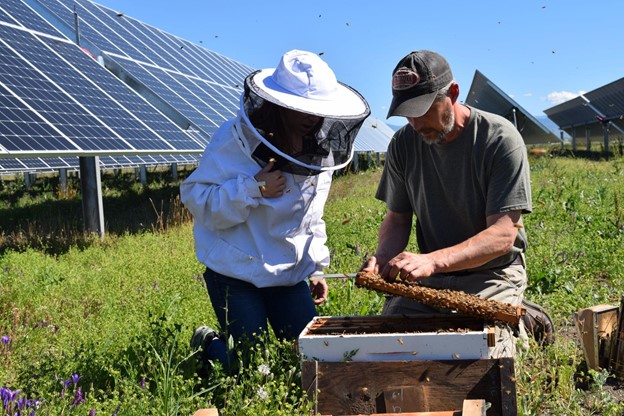by Diane Brandt
When I think about dual-use solar, I think about why this approach is a good idea for the Pacific Northwest. In a region that enjoys wild, open areas, it would be easy to assume that there’s “plenty of space” for building solar. Of course, as we look closer, we realize that there are many uses and users of these spaces and lands – between agriculture, conservation, and the plentiful ways to recreate in the great outdoors of the Pacific Northwest. Oregon and Washington have rich agricultural economies and histories that are entwined with their natural resources and beauty. As a native Oregonian myself, I recognize the connection I have and value I place on these pristine spaces and activities. Protecting those spaces and activities is important to many.
Equally important to many is meeting our climate goals through reducing our use of carbon-emitting energy resources. The impacts of greenhouse gas emissions on our climate in the Pacific Northwest have been more stark – in one year we experienced ice storms that knocked out power around the region, endured an extreme heat dome that killed hundreds of people, continued to deal with extreme drought, and watched another destructive wildfire season that saw fires so intense they created their own weather systems and shut down interstate power lines. Moving away from carbon-intense energy sources to fill our electricity grid is a near-term solution within our grasp to reduce the amount of greenhouse gas emissions we create.
So, back to why dual-use is relevant in the Pacific Northwest, it becomes a question of balance. As Oregon and Washington move toward their clean energy goals, considering ways to balance the building of renewable energy projects – especially wind and solar – with these existing land uses and conservation values are important. The conversation around dual-use solar is still evolving in the Pacific Northwest. From a handful of existing projects in Oregon that co-locate pollinators or native vegetation with solar arrays, to ongoing research at Oregon State University on the benefits of dual use, dual-use solar is still in its early stages.
As this is a newer concept for those in the region, it is safe to assume that opinions on dual use are mixed – with some viewing it with optimism in offering another way to generate clean energy while keeping land in “production,” yet others are skeptical of the effectiveness considering potential costs or the practicality of pairing solar with intense agriculture practices. Regardless, the region is looking at substantial renewableenergy projects in the near future to meet its clean energy goals, and exploring all potential solutions is no longer a luxury, but a necessity.
Back in 2019, Renewable Northwest staff saw the relevance of dual-use solar as a way to continue the conversation around solar in the region, and worked with Spark Northwest through the Solar Plus initiative – a project funded by the Department of Energy through the Washington State Department of Commerce – to create a report on dual-use solar and the Pacific Northwest. The report aims to explore the types of dual-use solar, the advantages and disadvantages of each, examples, and policies and best practices for dual use. The report does recognize that dual-use applications may not be suited for all situations, but it equally explores the areas where it could be a win-win for farmers and landowners alike.

Through exploring specific examples, the report does highlight some of the benefits of dual-use solar that go beyond the climate-friendly gains. One of these benefits is the potential for “off-farm” income that allows farmers to continue their agricultural activities through circumstances in which they would previously operate at a loss. Not only does this help keep farmers farming and producing crops that sustain our region, but it also keeps agricultural land as agricultural land.
However, as this report points out, the policy pathways in Washington and Oregon for dual use are unclear if not restrictive, as is the case in Oregon which limits dual-use solar to 12 acres (as of January 1, 2022) on high-value farmland. While I’m not suggesting that dual-use solar will meet all of the region’s clean energy needs, it certainly offers one way to contribute toward those goals while also offering co-benefits through enhancing farmers’ incomes, rehabilitating native vegetation or supporting pollinators, providing shade for grazing herds, to name a few.
So, why do I think dual-use solar is a good option for the Pacific Northwest? It not only offers gains toward a cleaner electricity grid, but it allows for flexibility in solar installation that can respond to the landowner or farmers’ needs. It offers us another tool to answer our climate concerns – and we’re going to need all the tools we can get!
The author is the Oregon Policy Manager at Renewable Northwest, a regional nonprofit advocating for the equitable and responsible decarbonization of the electricity grid with members from the renewable energy industry, and environmental and consumer groups.
